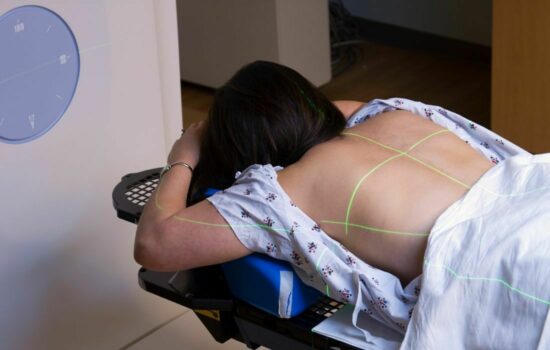October 12, 2022
When is Radiation Therapy Used for Lung Cancer?

Radiotherapy can be used to help treat a variety of different types of cancer, including lung cancer. But, there are several factors that play a role in deciding if or when radiation should be included in a patient’s treatment for lung cancer.
There can also be different goals for radiation therapy. In some cases, it’s meant to reduce the tumor size before surgery or to kill any remaining cancer cells in the body left after surgery, but it can also be used to shrink lung cancer tumors that are causing pain or other symptoms in distant parts of the body.
How Does Radiation Therapy Work?
Radiation therapy is most often given as “external beam” radiation for lung cancer treatment. High energy beams are directed to the area(s) of the body where the cancer is growing. Although internal radiation therapy, called high-dose brachytherapy, is also an option for some patients with lung cancer that has affected the airways. For this treatment, radioactive seeds are placed inside the body for a short period of time to deliver radiation to the affected area and then removed after several minutes.
Radiation therapy may be used as the only cancer treatment or given with other treatments, such as surgery, chemotherapy, or targeted therapy. The exact recommendation for each patient depends on the type of lung cancer being treated, the stage of the cancer, and the location and size of the tumor.
Common Types of External Beam Radiation Therapy for Lung Cancer
When treating small cell lung cancer (SCLC) and non-small cell lung cancer (NSCLC), radiation can be delivered with one of several external beam technologies such as:
Intensity Modulated Radiation Therapy (IMRT) - This is a popular form of external beam radiotherapy because it uses images from CT scans to precisely plan where the radiation beams will target, helping reduce damage to healthy tissue by focusing the dose on the tumor.
Stereotactic Body Radiation Therapy (SBRT) - this type of radiation therapy focuses high doses of radiation on small areas in or around the tumor to minimize damage to surrounding tissue.
When Do Patients with Lung Cancer Receive Radiation Therapy?
Radiation therapy is often used as part of the initial treatment for patients with early-stage non-small cell lung cancer. For later-stage patients, radiation therapy may be used to shrink tumors that have developed in areas of the body outside of the lungs.
Before starting any cancer treatment, the oncology team – including the medical oncologist, radiation oncologist, and surgeon – will discuss the best treatment recommendation based on several factors. Depending on your situation, radiation can be used in one or more periods of the treatment process.

Radiation Before Surgery to Remove Lung Cancer
If the lung cancer tumor is large, radiation therapy may be given before surgery to shrink the tumor. This reduces the amount of tissue removed during surgery and is known as neoadjuvant therapy.
Giving radiation before surgery can make it easier for surgeons to remove the tumor. It also might make it less likely that cancer will return after surgery.
In some cases, patients who would not have been able to have surgery because the tumor was too large or close to important blood vessels or other structures may be able to have surgery after getting radiation therapy.
Radiation Therapy as the Primary Treatment Method for Lung Cancer
There are some cases where patients only receive radiotherapy for their lung cancer treatment. This is more common among those who aren’t healthy enough to use chemotherapy or targeted drugs.
Post-Surgery Lung Cancer Radiation Therapy
Lung cancer patients undergoing surgery to remove the tumor may also receive radiation therapy afterward. This is done to help kill any cancer cells that may remain in the area. The type of surgery you have will affect when you receive radiation therapy. Radiation therapy is typically given after surgeries like a lobectomy (a lobe of the lung is removed) or a pneumonectomy (all of the lungs are removed).
Treat Lung Cancer in Distant Areas of the Body
If lung cancer has spread into other areas of the body, these areas will be included as part of the lung cancer treatment plan. This can even include times when cancer has spread to the brain or the bones. Radiation therapy can help to shrink the lesions in other parts of the body. In these cases, radiation may be used to help treat pain, bleeding, or difficulty swallowing that has been caused by the cancer.
Preventive (Prophylactic) Radiation Therapy
Small cell lung cancer patients are sometimes treated with radiotherapy in the brain before tumors appear because it’s common for SCLC to start developing there.
Lung Cancer Radiation Therapy Side Effects
This type of treatment can come with side effects such as:
Fatigue
Skin irritation (including redness or peeling like a sunburn)
Difficulty swallowing
Sore throat
Dizziness
Cough
Loss of appetite
Hair loss in treatment areas
Talk to your lung cancer specialist about the risks and benefits of radiation therapy before starting treatment. And tell your radiation therapist if you’re experiencing these side effects of treatment so they can help with tips for what you can do for relief.
Radiation Therapy for Lung Cancer Treatment in Brevard County
It’s important to do your research about the radiation oncologist you choose, the technologies available at their practice, and the convenience of the location. Typically, patients receiving radiation therapy for lung cancer treatment have an appointment approximately five days a week for somewhere between 4 and 8 weeks. Make sure it’s easy to get there, park, and get into the building.
If you or a loved one needs radiation therapy for lung cancer, the oncologists at Cancer Care Centers of Brevard can help. Our cancer centers offer the latest radiation therapies to Brevard County residents, including those in Melbourne, Merritt Island, and Palm Bay. With an experienced team dedicated to your care, treatments will be personalized to your individual needs. Whether it's radiotherapy for small cell lung cancer treatment or non-small cell lung cancer treatment, our approach ensures that you'll feel comfortable throughout the process with a treatment plan tailored to you.
Categories: Lung Cancer, Radiation Therapy